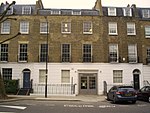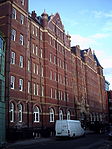Dublin Castle, Camden
Buildings and structures in the London Borough of CamdenCamden TownMusic venues in LondonPubs in the London Borough of Camden

The Dublin Castle is a pub and live music venue in Camden Town, London. It was built for Irish navvies working on railways in London, but gained prominence as a venue in the late 1970s after the band Madness established a live reputation there. Subsequently, it was an important venue in the early stages of several bands' careers and contributed to the Britpop musical genre. Amy Winehouse was a regular visitor to the pub.
Excerpt from the Wikipedia article Dublin Castle, Camden (License: CC BY-SA 3.0, Authors, Images).Dublin Castle, Camden
Parkway, London Chalk Farm (London Borough of Camden)
Geographical coordinates (GPS) Address Nearby Places Show on map
Geographical coordinates (GPS)
| Latitude | Longitude |
|---|---|
| N 51.537222222222 ° | E -0.14555555555556 ° |
Address
PizzaExpress
Parkway 85-87
NW1 7PP London, Chalk Farm (London Borough of Camden)
England, United Kingdom
Open on Google Maps










